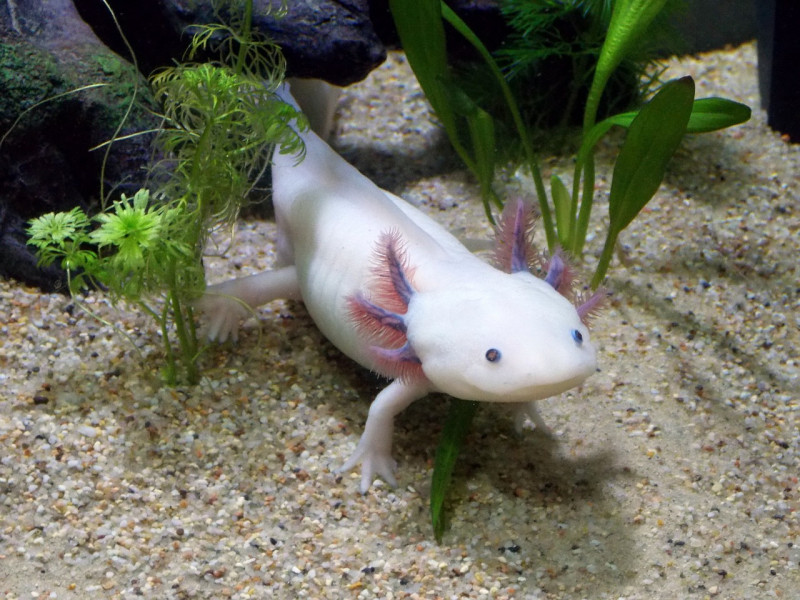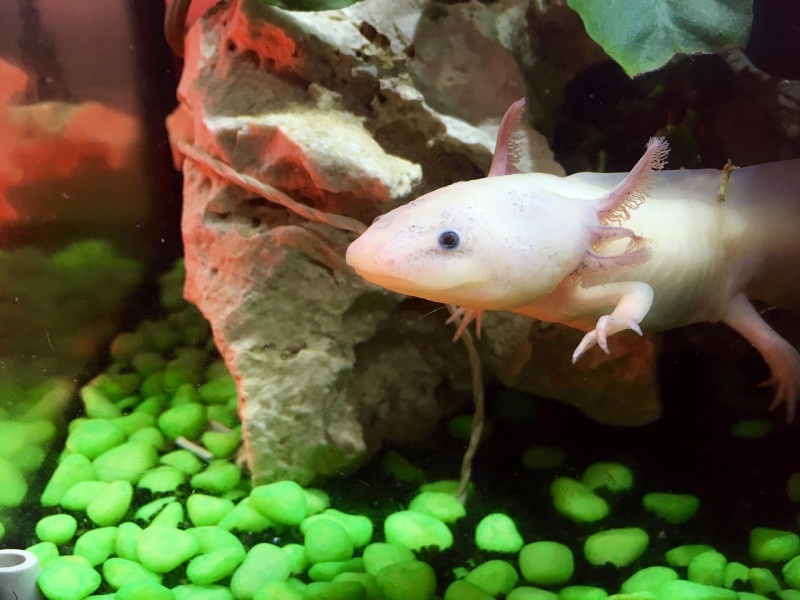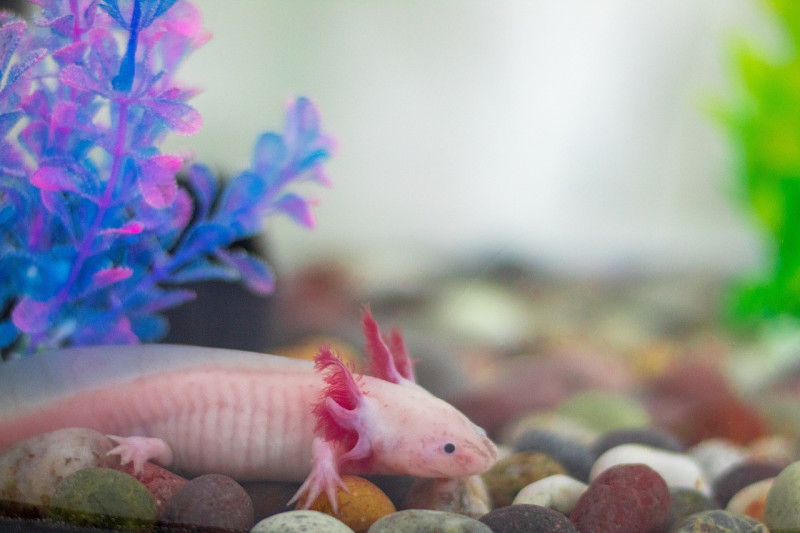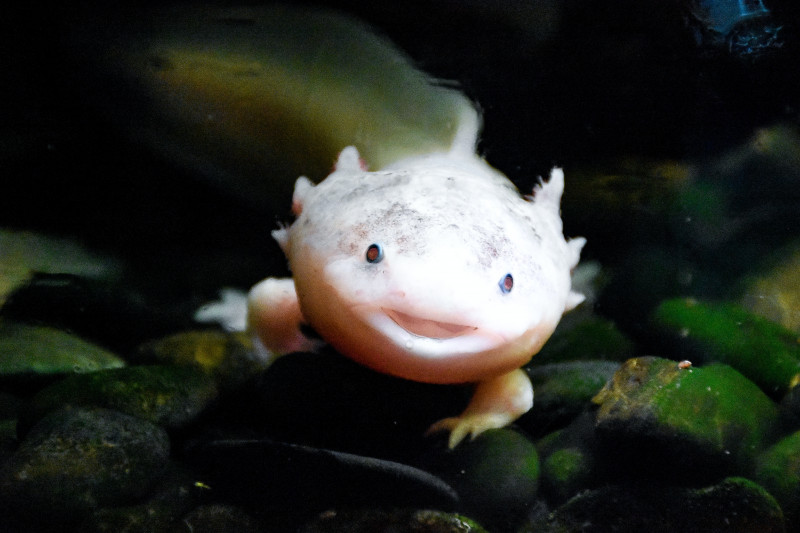
A proper tank setup not only ensures your axolotl’s well-being, but it also plays a significant role in their overall health, happiness, and longevity. Axolotls are unique amphibians with specific requirements that differ from most aquatic pets. Therefore, understanding and implementing the right tank setup is essential for providing your axolotl with the best possible living conditions and promoting their natural behaviors.
In setting up the perfect axolotl tank, it’s crucial to monitor your axolotl’s behavior to ensure they’re comfortable and healthy in their new environment. If you notice any abnormal behavior, be sure to check out our guide on Axolotl Abnormal Behavior: Common Causes and Solutions for help.
Designing an axolotl-friendly environment involves careful consideration of various factors, such as tank size, substrate, water parameters, filtration, decorations, and hideouts. Each component plays a vital role in creating a thriving habitat that caters to your axolotl’s needs, ensuring they feel secure and comfortable in their new home. In this guide, we will delve into the details of setting up the perfect axolotl tank, providing you with valuable tips and insights to ensure your axolotl enjoys a happy and healthy life.
Choosing the Right Tank Size
Selecting the right tank size is crucial for the health and happiness of your axolotl. As a general rule of thumb, a single adult axolotl requires a minimum tank size of 20 gallons, with an additional 10 gallons for each additional axolotl. This translates to a 30-gallon tank for two axolotls, a 40-gallon tank for three, and so on. Keep in mind that axolotls can grow up to 12 inches long, so providing ample space is essential to accommodate their size and swimming needs.
When choosing a tank, it’s important to consider its dimensions. Axolotls are bottom-dwellers and prefer a tank with a larger surface area rather than a tall, narrow one. A long, low-profile tank allows for greater horizontal swimming space and enables you to create multiple hiding spots and resting areas for your axolotl.
Opting for a larger tank offers numerous benefits for your axolotl’s health and well-being:
- Enhanced water quality: A larger tank dilutes waste more effectively, which helps maintain stable water parameters and reduces the risk of harmful ammonia and nitrite spikes. This is particularly important for axolotls, as they are sensitive to water quality changes.
- Reduced stress: Providing ample space allows your axolotl to swim freely, explore, and establish their territory. This reduces stress levels and encourages natural behaviors, contributing to a happier and healthier axolotl.
- More stable temperature: Larger water volumes are less prone to rapid temperature fluctuations, ensuring a more stable and comfortable environment for your axolotl.
- Room for decorations and hideouts: A larger tank enables you to create a more natural and enriching environment with various hiding spots, resting areas, and decorations that cater to your axolotl’s instincts and preferences.
- Flexibility for future additions: Should you decide to introduce another axolotl or upgrade your tank setup, a larger tank provides the flexibility and space needed to accommodate these changes without causing additional stress to your axolotl.
By investing in a larger tank, you can create a more comfortable, stable, and engaging environment that promotes your axolotl’s overall health and happiness.

Selecting the Best Substrate
Choosing the right substrate is an essential aspect of setting up the perfect axolotl tank. There are several options available, each with its pros and cons. Here, we will explore the most common substrate options for axolotl tanks:
- Bare-bottom: A bare-bottom tank has no substrate, making it easy to clean and maintain. This option is suitable for those who prefer a minimalist setup or want to simplify tank maintenance. However, it may not be as visually appealing or provide a natural environment for your axolotl.
- Fine sand: Fine sand is a popular choice for axolotl tanks, as it closely resembles their natural habitat. Sand is soft on their delicate skin and reduces the risk of impaction. However, it may require more frequent cleaning and can sometimes harbor harmful bacteria.
- Large river rocks: Smooth, large river rocks provide a natural-looking substrate and are less likely to cause impaction. They also create crevices for axolotls to explore. However, large rocks can be challenging to clean and may not provide the soft surface that axolotls prefer.
- Tile: Ceramic or slate tiles are easy to clean and maintain, making them a practical choice for axolotl tanks. Tiles also create a smooth surface for axolotls to move around on. However, they do not provide a natural look or feel for your tank.
When selecting a substrate for your axolotl tank, it’s crucial to consider the potential safety concerns and risks associated with each option:
- Impaction: Axolotls can accidentally ingest small particles of substrate while feeding, which can lead to impaction – a potentially life-threatening condition. To minimize this risk, avoid using gravel or any substrate with particles small enough for your axolotl to swallow.
- Abrasions and cuts: Sharp or rough substrates can cause injury to your axolotl’s delicate skin. Always choose a substrate with smooth surfaces or fine particles, such as sand or large river rocks, to prevent abrasions and cuts.
- Bacterial growth: Some substrates can harbor harmful bacteria, especially if not cleaned regularly. Be diligent about maintaining proper tank hygiene and regularly cleaning your substrate to prevent bacterial growth that could harm your axolotl.
- Chemical leaching: Ensure that the substrate you choose is free of any harmful chemicals that could leach into the water and harm your axolotl. This is particularly important when using natural stones or tiles, which may have been treated with chemicals during manufacturing.
Water Parameters and Filtration
Axolotls are cold-water amphibians that require specific temperature conditions to thrive. The ideal water temperature for axolotls ranges from 60 to 64°F (15 to 18°C). It’s crucial to maintain a stable temperature within this range, as higher temperatures can stress your axolotl, making them more susceptible to illness. To monitor the water temperature, use a reliable aquarium thermometer, and make necessary adjustments using a fan or aquarium chiller if required. Avoid using heaters, as they can raise the water temperature beyond the safe range for axolotls.
Maintaining the proper pH levels in your axolotl tank is essential for creating a healthy environment. Axolotls prefer a slightly alkaline water pH between 7.4 and 7.8. Consistent pH levels prevent stress and promote overall health. To maintain the correct pH, use a reliable pH test kit to monitor the levels regularly. If necessary, you can adjust the pH using products specifically designed for aquarium use, such as pH buffers or natural pH raising solutions like crushed coral or limestone.
A suitable filtration system is vital for maintaining water quality in your axolotl tank. It removes harmful substances, such as ammonia and nitrite, and keeps the water clean and clear. There are several filtration options to choose from, each with its advantages:
- Hang-on-back (HOB) filters: These filters are easy to install and maintain, making them an excellent option for beginners. HOB filters provide mechanical, chemical, and biological filtration, ensuring optimal water quality. However, they can create strong water currents, which may stress your axolotl. To counteract this, use a sponge to cover the filter output and create a gentler flow.
- Sponge filters: Sponge filters are a popular choice for axolotl tanks, as they provide gentle water flow and efficient biological filtration. They are easy to clean and maintain, making them a cost-effective option. However, sponge filters do not offer chemical filtration and may require supplemental mechanical filtration to remove larger debris.
- Canister filters: Canister filters are a high-capacity filtration option suitable for larger tanks or multiple axolotls. They provide efficient mechanical, chemical, and biological filtration and allow for customizable media selection. Canister filters can also be adjusted to create a gentle water flow suitable for axolotls. However, they are more expensive and require more maintenance compared to other filter types.
When choosing a filtration system, consider your tank size, the number of axolotls, and your maintenance preferences.

Tank Decorations and Hideouts
Axolotls are naturally shy and reclusive creatures that need hiding spots in their tank to feel secure and comfortable. Providing hiding spots can significantly reduce stress and promote a sense of security, contributing to the overall well-being of your axolotl. Additionally, hiding spots offer a retreat where axolotls can escape from bright lights and rest during the day, as they are primarily nocturnal animals.
There is a wide variety of tank decorations that can be used to create hiding spots and enhance the aesthetics of your axolotl tank. When selecting decorations, keep in mind that axolotls are soft-bodied and delicate, so choose items that are smooth and free of sharp edges. Some suitable decorations for axolotl tanks include:
- Caves and tunnels: Ceramic, resin, or PVC pipe caves and tunnels provide excellent hiding spots for axolotls. Ensure that the openings are large enough for your axolotl to move in and out comfortably and that the material is safe for aquatic use.
- Artificial plants: Soft, silk or plastic plants can offer additional cover for axolotls to hide among. Choose plants with broad leaves or bushy designs to create a sense of security.
- Driftwood and rocks: Smooth driftwood and rounded rocks can be used to create natural-looking hiding spots in your tank. Be sure to clean and sterilize them properly before use to avoid introducing harmful bacteria or parasites into your aquarium.
When arranging decorations and hideouts in your axolotl tank, consider the following tips to create an optimal environment:
- Spread hiding spots evenly: Place hideouts and decorations throughout the tank to offer your axolotl multiple retreat options. This allows them to choose the spot they feel most comfortable in and helps prevent territorial disputes if you have more than one axolotl.
- Allow for open space: While providing ample hiding spots is essential, ensure there is enough open space for your axolotl to swim and explore. Overcrowding the tank with decorations can be stressful for your axolotl and make it challenging to maintain water quality.
- Anchor decorations: Securely anchor decorations, especially plants, to prevent them from being dislodged or uprooted by your axolotl’s movements.
- Regular cleaning: Ensure decorations and hideouts are cleaned regularly to prevent the buildup of algae, debris, and harmful bacteria. Clean them during routine tank maintenance, taking care not to disturb your axolotl too much in the process.
Lighting and Tank Placement
Axolotls are naturally nocturnal and sensitive to bright light, so it’s essential to create a comfortable environment with appropriate lighting conditions. Ideally, axolotl tanks should have low to moderate lighting to mimic their natural habitat and reduce stress. You can achieve this by following these tips:
- Use subdued lighting: When choosing an aquarium light, opt for a low-wattage LED light that provides a gentle, diffused illumination. LED lights also generate less heat than other types of lighting, which helps maintain a stable water temperature.
- Limit natural light: While axolotls can benefit from some natural light, avoid placing the tank in direct sunlight, as this can cause overheating and excessive algae growth. Instead, opt for a location with indirect or filtered natural light.
- Provide a day-night cycle: Axolotls benefit from a regular day-night cycle, so set a timer for your aquarium light to turn on and off at appropriate times, mimicking a natural 12-hour light and 12-hour dark cycle.
Choosing the right location for your axolotl tank is crucial for maintaining optimal temperature and light conditions. Consider the following factors when selecting a spot for your aquarium:
- Avoid direct sunlight: As mentioned earlier, direct sunlight can cause the water temperature to rise and promote excessive algae growth. Choose a location away from windows or bright sunlit areas.
- Stay away from heat sources: Axolotls require cool water temperatures (15-20°C or 59-68°F), so avoid placing the tank near radiators, vents, or other heat-generating appliances.
- Limit exposure to drafts: Sudden temperature fluctuations can stress your axolotl, so try to position the tank away from drafty areas like open windows or doors.
- Choose a stable surface: Ensure that the tank is placed on a sturdy, level surface capable of supporting its weight when filled with water. A dedicated aquarium stand is recommended for larger tanks.
- Provide accessibility: Place your tank in a location where it’s easy for you to access it for feeding, cleaning, and general maintenance.

Cycling the Tank
The nitrogen cycle is a crucial biological process that occurs in every aquatic environment, including your axolotl tank. It involves the conversion of harmful substances like ammonia, produced by axolotl waste and decaying organic matter, into less toxic compounds such as nitrite and eventually nitrate. This process is facilitated by beneficial bacteria that colonize your tank’s surfaces and filtration system.
The nitrogen cycle typically involves the following steps:
- Ammonia (NH3) is produced from axolotl waste, uneaten food, and decaying plants.
- Nitrosomonas bacteria convert ammonia into nitrite (NO2-), which is still harmful to aquatic life.
- Nitrobacter bacteria then convert nitrite into nitrate (NO3-), a less toxic compound that can be managed through regular water changes.
Cycling the tank before introducing axolotls is essential for their health and well-being. This process allows the beneficial bacteria to establish and become capable of processing harmful waste products, creating a safer environment for your axolotl. Introducing axolotls into an uncycled tank can expose them to high levels of ammonia and nitrite, causing stress, illness, and even death.
To ensure your axolotl tank is adequately cycled before adding your new pet, follow these steps:
- Set up the tank: Assemble the tank with the appropriate substrate, filtration system, decorations, and water. Make sure the water is dechlorinated and within the proper temperature range. This provides a stable environment for the beneficial bacteria to grow and establish themselves.
- Introduce a source of ammonia: To start the cycling process, you’ll need to add a source of ammonia to the tank. This can be done by adding a small amount of fish food or pure ammonia. This initial ammonia source will help kick-start the growth of beneficial bacteria necessary for the nitrogen cycle.
- Monitor water parameters: Using a water testing kit, regularly test the ammonia, nitrite, and nitrate levels in the tank. Over time, you should see ammonia levels decrease, followed by nitrite levels, as beneficial bacteria establish and process these compounds. It’s essential to monitor these parameters closely to ensure the cycling process is progressing as expected.
- Maintain patience and consistency: Cycling a tank can take anywhere from 2 to 6 weeks, depending on various factors like temperature, pH, and the amount of beneficial bacteria present. Be patient during this process and continue to monitor the water parameters. Resist the urge to add your axolotl before the tank has completed cycling, as doing so could be harmful to their health.
- Perform water changes: Once ammonia and nitrite levels reach zero and nitrate levels are detectable, perform a 25-50% water change to reduce the nitrate concentration. This helps ensure a safe environment for your axolotl.
- Introduce your axolotl: After the tank is fully cycled and water parameters are stable, it’s safe to add your axolotl to their new home. Be sure to acclimate them to the new water conditions gradually to minimize stress. This can be done by slowly introducing tank water into the container holding your axolotl over a period of 30 minutes to an hour.
By carefully following these steps, you’ll create a healthy, stable environment that supports your new axolotl’s well-being and longevity. Remember that patience is key during the tank cycling process, and the extra time spent will ensure a thriving environment for your axolotl.
Ongoing Tank Maintenance Tips
- Schedule and frequency: Performing regular water changes is crucial to maintaining a healthy axolotl tank. Ideally, you should change about 20-30% of the water every 1 to 2 weeks, depending on the tank size, number of axolotls, and water quality. Regular water changes help maintain stable water parameters by removing excess waste, uneaten food, and other debris that accumulate over time. This process also reduces harmful substances like ammonia, nitrite, and nitrate, ensuring a clean and healthy environment for your axolotl.
- Techniques: When performing a water change, use a siphon or gravel vacuum to remove debris from the substrate. Be sure to replace the removed water with dechlorinated water that matches the temperature and pH of the tank.
- Water testing: Consistently test your tank’s water parameters using a water testing kit. This allows you to monitor the levels of ammonia, nitrite, nitrate, and pH, and make any necessary adjustments to maintain a safe and healthy environment.
- Monitor water parameters: Regularly test your tank’s water parameters, such as temperature, pH, ammonia, nitrite, and nitrate levels, using a water testing kit. Maintaining ideal water conditions is crucial to the health and well-being of your axolotl.
- Temperature: Axolotls thrive in water temperatures between 60-68°F (15-20°C). Use a reliable aquarium heater or chiller, if necessary, to maintain a consistent temperature within this range. Also, install a high-quality thermometer to monitor temperature fluctuations.
- pH levels: The ideal pH range for axolotls is between 7.0-7.5. To maintain a stable pH, use natural solutions like crushed coral or limestone, or commercial pH buffers as needed. Regularly monitor pH levels to ensure they remain within the desired range.
- Filter maintenance: Clean and maintain your filter regularly to ensure its optimal performance. Replace filter media as recommended by the manufacturer, and avoid cleaning all media at once to preserve beneficial bacteria. When cleaning the filter, use tank water instead of tap water to prevent killing beneficial bacteria.
- Beneficial bacteria: Encourage the growth of beneficial bacteria in your tank by providing ample surface area for colonization, such as porous filter media, bio-balls, or ceramic rings. These bacteria help break down harmful substances like ammonia and nitrite, promoting a healthy and stable environment for your axolotl.
This post currently has 4 responses.
-
Wow these guys are so neat! I’m pretty sure I seen these at our local Zoo a few days back on Earth Day. If it wasn’t them, then it had to be part of their family, because they look very similar. Very interesting read! I didn’t even know you could buy these!
-
GAHHH! Oh my goodness, these are beyond adorable! I love how they look like they are happy and smiling all of the time. They are TOO cute and look like kissy face surreal fantasy creatures. They make me smile inside and out just looking photos of them. My cousin had 2 of them as pets for her family.
-
I finally saw one of these on youtube. My great niece love (6) fish and youtube is her favorite thing to watch. She was telling me about this aquarium show she was watching…………. so we pulled it up……. AND THERE HE/IT/SHE WAS






This is so cool I have never saw these before. Have been thinking about getting and setting up a fish tank………….. BUT now I think I would love to have one. I need to go to the fish store and talk to them about this.